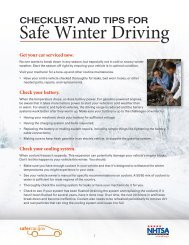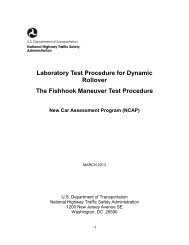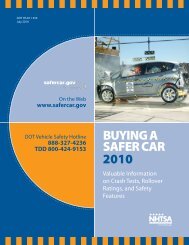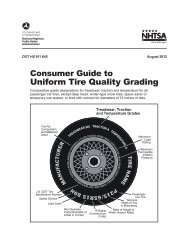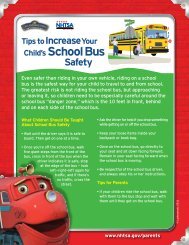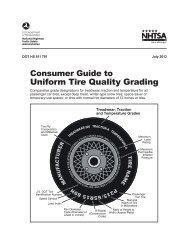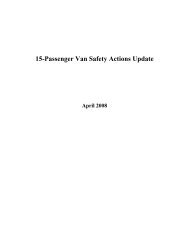U.S. DEPARTMENT OF TRANSPORTATION - SaferCar.gov
U.S. DEPARTMENT OF TRANSPORTATION - SaferCar.gov
U.S. DEPARTMENT OF TRANSPORTATION - SaferCar.gov
You also want an ePaper? Increase the reach of your titles
YUMPU automatically turns print PDFs into web optimized ePapers that Google loves.
SINCAP MDB - 32<br />
H. CALCULATION <strong>OF</strong> VEHICLE TARGET TEST WEIGHT<br />
(1) Calculate the Rated Cargo and Luggage Weight (RCLW) as follows and record<br />
on Data Sheet No. 1:<br />
RCLW = VCW – (68.04 kg x DSC)<br />
VCW = the Vehicle Capacity Weight from the vehicle placard, also taking into<br />
account any reduction in load capacity.<br />
DSC = the Designated Seating Capacity as indicated on the vehicle placard.<br />
FOR TRUCKS, MPV’s or BUSES - If the RCLW calculated above is greater<br />
than 136 kg, use 136 kg as the RCLW.<br />
(2) Weigh the fully-instrumented dummies to be used.<br />
(3) Calculate the Test Vehicle Target Weight (TVTW) by summing the “As Delivered”<br />
weight, the RCLW, and the weight of the fully instrumented ES-2re and SID-IIs<br />
dummies:<br />
TVTW = As Delivered Weight + RCLW + ES-2re weight + SID-IIs weight<br />
Record the TVTW.<br />
I. “FULLY LOADED” VEHICLE WEIGHT CONDITION<br />
(1) With the vehicle in the “As Delivered” weight condition, load the vehicle with the<br />
ballast equal to the RCLW placed in the luggage or load carrying/cargo area.<br />
Center the load over the longitudinal centerline of the vehicle.<br />
(2) Place the weight of the fully instrumented test dummies (with clothes and shoes)<br />
in the appropriate front and rear outboard seating positions.<br />
(3) Weight the vehicle at each wheel and add the weights together to determine the<br />
“Fully Loaded” weight. Record the weight measurements on Data Sheet No. 1.<br />
J. VEHICLE ATTITUDE AND CG MEASUREMENTS – “FULLY LOADED” WEIGHT<br />
CONDITION<br />
(1) Place the vehicle on a flat, level surface in the “Fully Loaded” weight condition.<br />
(2) If the vehicle has an Auto-Leveling System, the ignition must be set to the “on”<br />
position. If the vehicle is equipped with a self-adjusting hydraulic system, contact<br />
the COTR for further guidance on attitude measurements.<br />
(3) If the vehicle has been raised off of the ground to make weight measurements,<br />
the vehicle should be rolled for at least 10 meters and left to settle for at least 10<br />
minutes prior to moving to step (4).<br />
(4) “Exercise” the vehicle’s suspension system by pushing down and pulling up on<br />
each of the four corners of the vehicle at least 5 times in an interval not to exceed<br />
40 seconds each. Allow the vehicle to settle for at least 10 minutes.<br />
(5) Mark a reference point on the test vehicle’s body, directly above each wheel<br />
opening.<br />
(6) For each wheel well, measure the distance between the ground and each of the<br />
reference points. Record each measurement on Data Sheet No. 1.<br />
(7) Measure and record the vehicle CG aft of the front axle and left(+)/right(-) from<br />
the longitudinal centerline on Data Sheet No. 1.



